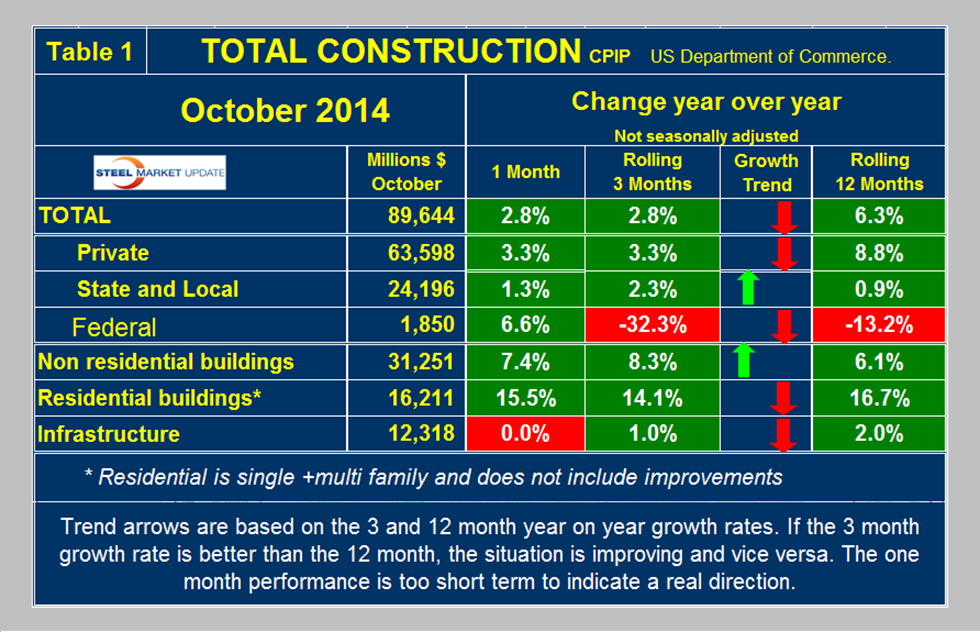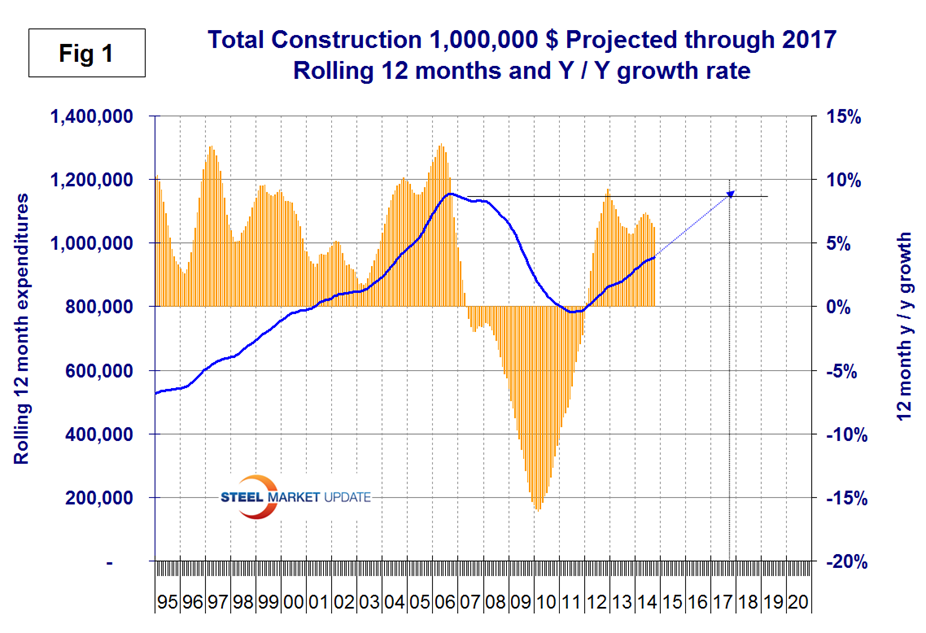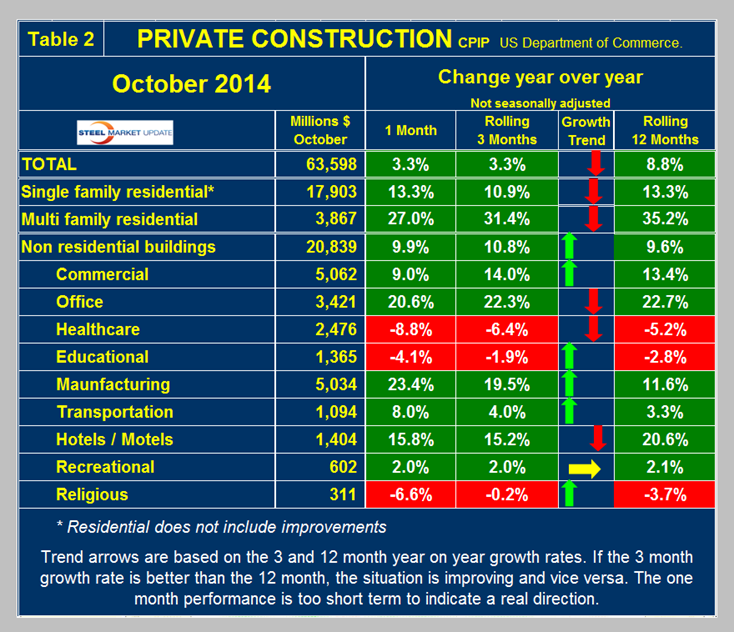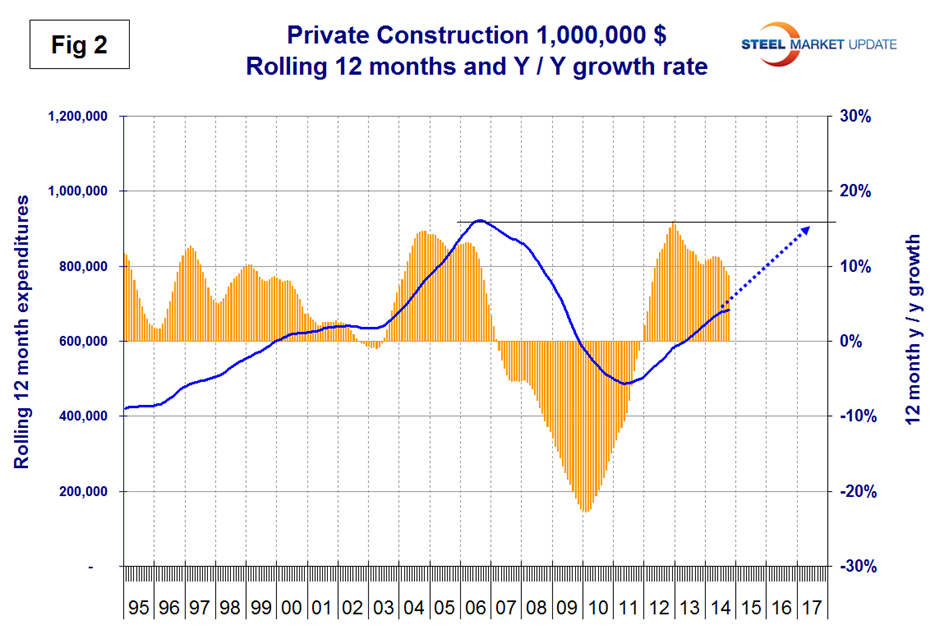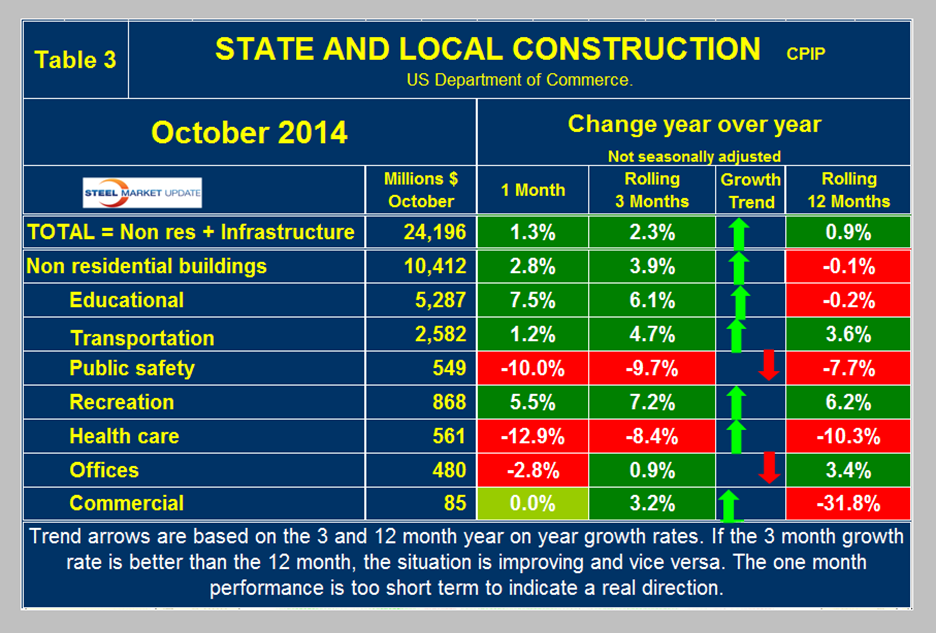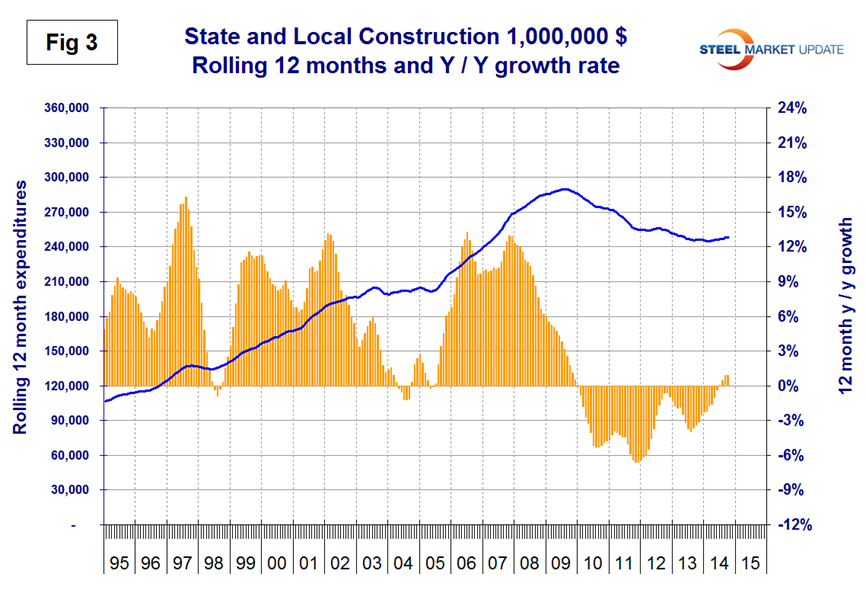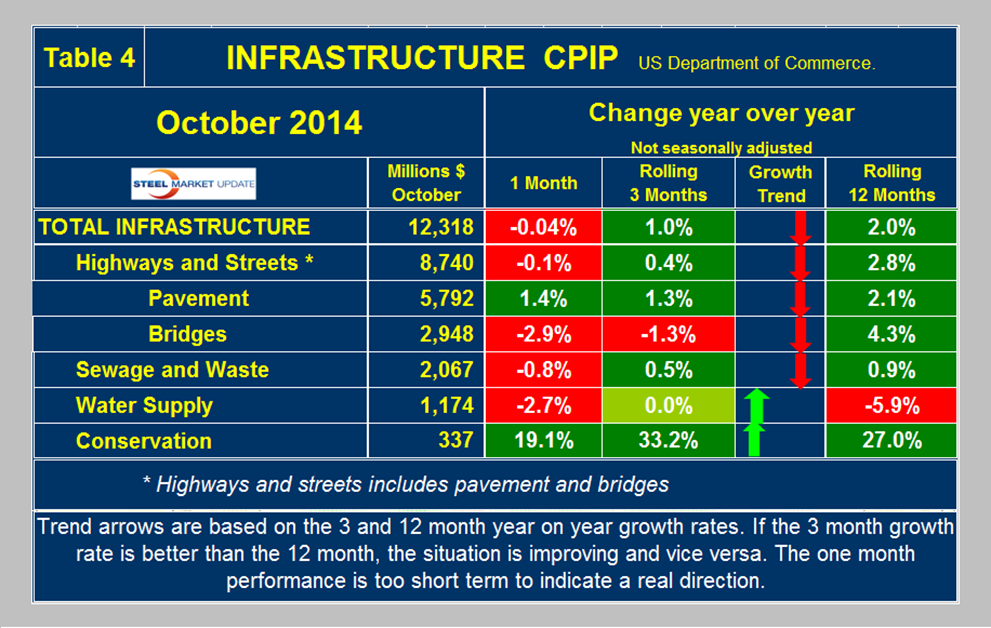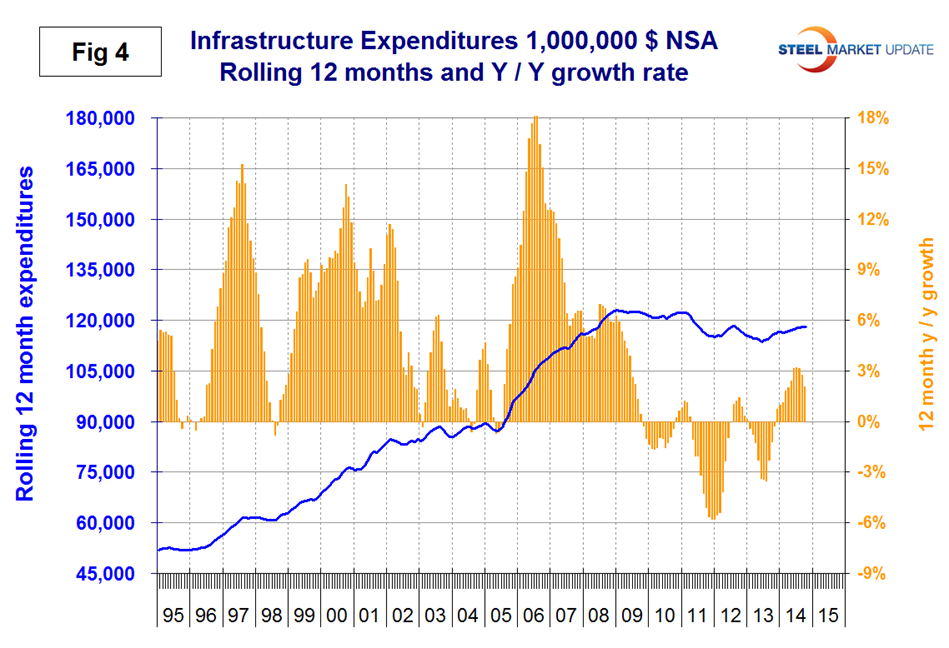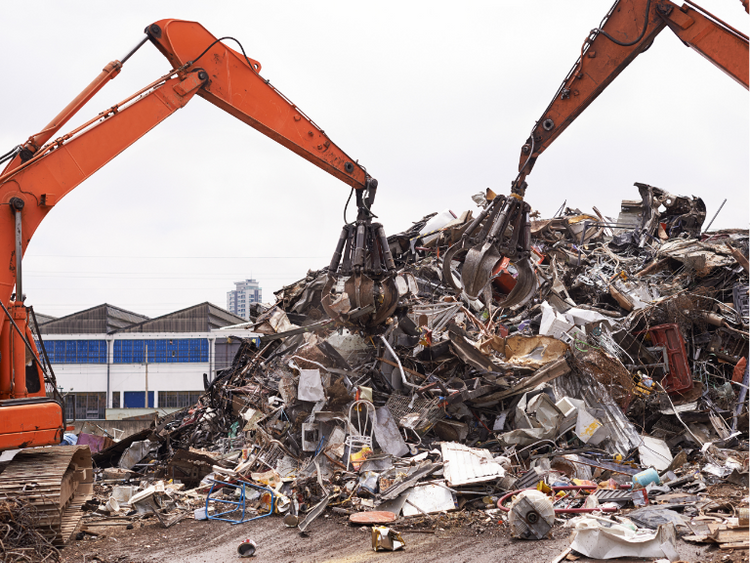Analysis

December 3, 2014
Construction Expenditures through October 2014
Written by Peter Wright
Each month the Commerce Department issues its construction put in place (CPIP) data, usually on the first working day covering activity two months earlier. October data was released on December 2nd. Construction put in place is based on spending work as it occurs, estimated for a given month from a sample of projects. In effect the value of a project is spread out from the project’s start to its completion. Construction starts data published by the Commerce Department for residential construction and by McGraw Hill / Dodge and Reed Construction for non-residential is completely different as in these cases the whole project is entered to the data base when ground is broken. The official CPIP press report gives a very limited view of expenditures and trends on a historical basis. The detail is hidden in the published data tables which we at SMU dissect to try to provide some meaningful guidance for those readers whose businesses target this industry. This is a very broad and complex subject therefore to make this monthly write up more comprehensible we are keeping the information format as consistent as possible.
Total Construction: Data is reported on both a seasonally adjusted and non-adjusted basis. In the SMU analysis we consider only the non-seasonally adjusted data and remove seasonality by the consideration of year over year (y/y) data. We also focus on rolling 3 and 12 months to remove the noise in single month numbers. Please note that the official news release from the Commerce Department may at first glance seem to conflict with the SMU analyses because the government commentary is all about seasonally adjusted numbers.
October expenditures were $89.6 billion which breaks down to $69.6 B of private work, $21.2 B of state and locally, (S&L) funded work and $1.9 B of federally funded, (Table 1).
On a rolling three month basis total construction was up by 2.8 percent y/y, a decline from 3.3 percent in our last report. On a rolling 12 month basis y/y total construction was up by 6.3 percent, a decline from 6.5 percent in September. This means that total construction growth is decelerating since the short term growth (3 months 2.8 percent) is less than the long term, (12 months 6.3 percent). We report this as negative momentum. Note this is not a seasonal effect because our y/y analysis removes seasonality. Private work had negative momentum in September but state and local momentum was positive, both trends the same as they were in the June, July, August and September results. Federally funded construction is in a complete swoon being down by 32.3 percent on a rolling three months year over year basis. In every month so far in 2014 the rolling three months Federal construction expenditures have been >30 percent less than the same period a year earlier. We consider three sectors within total construction. These are non-residential, residential and infrastructure. On a rolling three month basis y/y non-residential is growing at 8.3 percent and accelerating. Residential is growing at 14.1 percent and slowing. Infrastructure grew 1.0 percent y/y and decelerated in the last three months with negative momentum. The growth of total construction improved from December through June but has been slowing since June as shown by the brown bars in Figure 1. The trajectory of total annual expenditures has flattened as shown by the blue line which, if this trend continues will push our projection of recovery to the pre-recession peak out several years. The pre-recession peak of total construction on a rolling 12 month basis was $1,145 B in 12 months through February 2007. The low point was $768 B in 12 months through May 2011. The 12 month total through the latest data of October 2014 was $954.9 B.
Private Construction: In the October CPIP data, private work decelerated significantly from a 8.8 percent growth rate in 12 months y/y to a 3.3 percent rate in 3 months y/y, (Table 2).
This was only the second time in 26 months for the 12 month growth to fall below 10 percent as shown by the brown bars in Figure 2. We had been projection a full recovery of private construction sometime in 2017 but this is slipping. Table 2 breaks down the private sector into project types. Residential buildings, both single and multi-family still have strong y / y growth but both have negative momentum. The single family data coincides well with the housing starts data from the Census Bureau which has single family growing at an 11.3 percent rate but in this CPIP report multi-family is growing at 31.4 percent as the housing starts data has it growing at only 13.9 percent. Private non-residential buildings grew at a 10/8 percent rate in three months through October y/y with a positive momentum. Within private non-residential, only health care, educational and religious buildings had negative growth. Offices, manufacturing, hotels / motels and commercial continued to have strong year over year growth in three months through October
State and Local Construction: S&L work expanded by 2.3 in the rolling three months through October y/y. (Table 3).
This was the sixth consecutive month of positive y/y growth on a rolling three months basis, the first time that has happened in four years and momentum is positive as indicated by the three month growth rate being higher than the twelve month. Figure 3 shows three consecutive months of positive growth after 54 months of contraction. S&L non-residential building grew by 3.9 percent in three months through October y/y, and momentum continues to be positive. It looks as though state and local governments are beginning to loosen the purse strings as far as construction is concerned. Educational buildings are about 75 percent funded by state and local governments and are by far the largest sub sector of S&L non-residential at almost $5.3 billion in October. State and locally funded educational building construction expanded by 6.1 percent in three months through October, the best performance in 64 months. Recreational buildings have accelerated markedly in the last four months and grew by 7.2 percent in the latest data making this the strongest sector within State and Local. Transportation terminals continue to do well. Comparing Figures two and three it can be seen that S&L construction did not decline proportionately as much as private work during the recession. Many state and local governments are still far from healthy, as increased revenues have been more than offset by increased future obligations, including the need to replenish reserve and rainy-day funds and to service defined benefit liabilities, pensions and Medicaid foremost. In spite of these limitations S&L construction seems to have bottomed out and begun what will be a very long period of recovery to pre-recession levels.
Drilling down into the private and S&L sectors as presented in Tables 2 and 3 shows which project types should be targeted for steel sales and which should be avoided. There are some project types within S&L that are doing quite well but there are also major regional differences to be considered.
Infrastructure: expenditures have had positive growth in each of the last fourteen months through October on a rolling 3 months basis with a + 1.0 percent result in the latest data. The growth in three months is slower than that in 12 months meaning that momentum slowed as a result of protracted negotiations in Washington before the issue of highway trust fund had some limited resolution. Highway and streets including bridges accounts for about 2/3 of total infrastructure expenditures and has had positive growth for the last eleven months, (Table 4).
Highway pavement is the other main sub-component of highways and streets and it has had positive growth for the last six months. Water supply broke even in three months through October after 10 months of decline. There has been a surge in conservation expenditures this year but the outlays are relatively small. On a rolling 12 month basis, infrastructure expenditures are about where they were three years ago and the growth rate has been slowing for the last three months. (Figure 4).
The AGC (Associated General Contractors of America) made the following comments: Construction spending increased in October amid growing public-sector demand for construction and continued modest growth in residential. Association officials said the new spending figures underscore the need for measures to increase the supply of qualified construction workers as firms worry about growing labor shortages.
“Today’s data shows that construction growth remains volatile,” said Ken Simonson, the association’s chief economist. “While overall construction spending jumped by more than one percent in October, the gain followed two months of stagnation. Public construction was the fastest-growing segment for the month but the slowest-growing over the past year and for the first 10 months of 2014 combined. Conversely, private nonresidential construction inched down from September to October but has risen at double-digit rates–11 percent–for the combined January through October period. And private residential construction continues to grow very modestly, with multifamily construction taking the lead on an annual basis.”
The press release from the Commerce Department on Tuesday reads as follows:
October 2014 Construction AT $971.0 Billion Annual Rate
The U.S. Census Bureau of the Department of Commerce announced today that construction spending during October 2014 was estimated at a seasonally adjusted annual rate of $971.0 billion, 1.1 percent above the revised September estimate of $960.3 billion. The October figure is 3.3 percent above the October 2013 estimate of $939.9 billion.
During the first 10 months of this year, construction spending amounted to $800.6 billion, 5.8 percent above the $756.5 billion for the same period in 2013.
Private Construction: Spending on private construction was at a seasonally adjusted annual rate of $692.4 billion, 0.6 percent above the revised September estimate of $688.0 billion. Residential construction was at a seasonally adjusted annual rate of $353.8 billion in October, 1.3 percent above the revised September estimate of $349.1 billion. Nonresidential construction was at a seasonally adjusted annual rate of $338.6 billion in October, 0.1 percent below the revised September estimate of $338.9 billion.
Public Construction: In October, the estimated seasonally adjusted annual rate of public construction spending was $278.6 billion, 2.3 percent above the revised September estimate of $272.3 billion. Educational construction was at a seasonally adjusted annual rate of $64.5 billion, 2.2 percent above the revised September estimate of $63.1 billion. Highway construction was at a seasonally adjusted annual rate of $82.0 billion, 1.1 percent above the revised September estimate of $81.1 billion.



